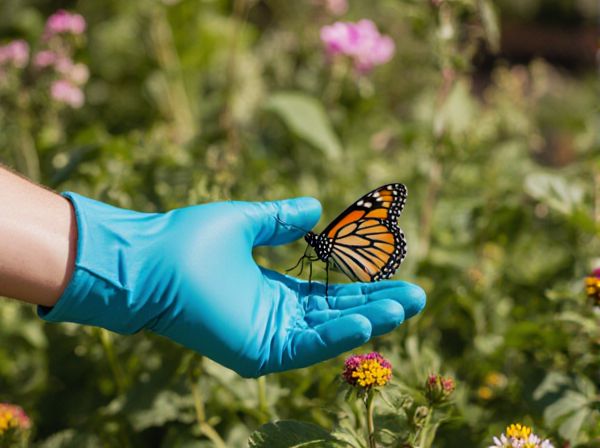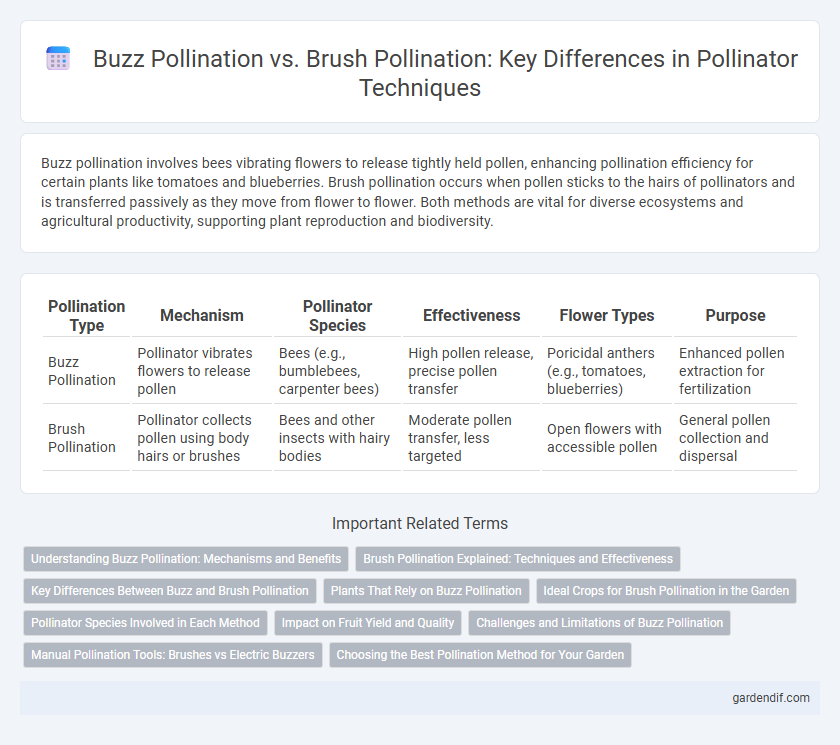
Buzz pollination vs brush pollination Illustration
Buzz pollination involves bees vibrating flowers to release tightly held pollen, enhancing pollination efficiency for certain plants like tomatoes and blueberries. Brush pollination occurs when pollen sticks to the hairs of pollinators and is transferred passively as they move from flower to flower. Both methods are vital for diverse ecosystems and agricultural productivity, supporting plant reproduction and biodiversity.
Table of Comparison
| Pollination Type | Mechanism | Pollinator Species | Effectiveness | Flower Types | Purpose |
|---|---|---|---|---|---|
| Buzz Pollination | Pollinator vibrates flowers to release pollen | Bees (e.g., bumblebees, carpenter bees) | High pollen release, precise pollen transfer | Poricidal anthers (e.g., tomatoes, blueberries) | Enhanced pollen extraction for fertilization |
| Brush Pollination | Pollinator collects pollen using body hairs or brushes | Bees and other insects with hairy bodies | Moderate pollen transfer, less targeted | Open flowers with accessible pollen | General pollen collection and dispersal |
Understanding Buzz Pollination: Mechanisms and Benefits
Buzz pollination, or sonication, involves bees vibrating their flight muscles to release pollen from flowers with specialized poricidal anthers, enhancing pollen transfer efficiency. This mechanism targets plants like tomatoes, blueberries, and cranberries, which traditional brush pollination fails to effectively pollinate due to their pollen's adhesive nature. The precise pollen release during buzz pollination improves crop yield and quality, making it a vital process in agricultural ecosystems dependent on pollinator activity.
Brush Pollination Explained: Techniques and Effectiveness
Brush pollination involves manually transferring pollen using a small brush or cotton swab, enabling precise control over pollen placement on flower stigmas. Techniques emphasize gentle brushing to avoid damaging delicate floral parts while maximizing pollen transfer efficiency, especially in controlled environments like greenhouses. This method proves highly effective for crops with inaccessible anthers or when specific cross-pollination is desired, enhancing fruit set and yield in species such as tomatoes and blueberries.
Key Differences Between Buzz and Brush Pollination
Buzz pollination involves bees vibrating their flight muscles to release pollen from flowers with tightly held anthers, enhancing pollen transfer efficiency. Brush pollination relies on direct contact between pollinators' bodies and floral reproductive structures, often resulting in less precise pollen placement. Buzz pollination is specialized for certain plant species like tomatoes and blueberries, while brush pollination occurs across a wider range of plants with exposed pollen.
Plants That Rely on Buzz Pollination
Plants that rely on buzz pollination, such as tomatoes, blueberries, and cranberries, depend on specific bee species like bumblebees that vibrate flowers to release pollen trapped in tubular anthers. Buzz pollination enhances pollen transfer efficiency, ensuring successful fertilization for these plants with poricidal anthers. Unlike brush pollination, which involves bees brushing pollen off open anthers, buzz pollination requires the unique behavior of sonication to dislodge pollen, making it critical for the reproduction of certain crop species.
Ideal Crops for Brush Pollination in the Garden
Brush pollination works effectively for crops with large, accessible flowers such as tomatoes, eggplants, and peppers, which rely on pollinators to transfer pollen from anthers to stigmas without requiring vibration. This method ensures thorough pollen distribution on open, brush-friendly flower surfaces, enhancing fruit set and yield. Ideal garden crops for brush pollination often feature shallow floral structures that facilitate manual or natural pollen transfer by insects with brush-like body parts.
Pollinator Species Involved in Each Method
Buzz pollination primarily involves bumblebees (genus Bombus), which vibrate flowers to release tightly held pollen, a technique essential for plants like tomatoes and blueberries. Brush pollination is common among honeybees (Apis mellifera) and solitary bees, which collect pollen by directly brushing against flower anthers and stigmas. Each pollinator species exhibits specialized behaviors and morphological traits that optimize pollen transfer efficiency for specific floral structures.
Impact on Fruit Yield and Quality
Buzz pollination, performed by bees vibrating flowers to release pollen, significantly enhances fruit yield by ensuring thorough pollen transfer, especially in crops like tomatoes and blueberries. Brush pollination, involving pollen deposition via insect body parts or artificial brushes, generally results in lower fruit set and quality due to less efficient pollen distribution. Studies indicate that buzz pollination correlates with improved fruit size, seed count, and uniform ripening, directly impacting agricultural productivity and market value.
Challenges and Limitations of Buzz Pollination
Buzz pollination relies on specific bee species capable of vibrating flowers to release pollen, limiting its effectiveness to crops and plants compatible with this method. The technique is less efficient in environments lacking these specialized pollinators, resulting in inconsistent pollen transfer and reduced crop yields. Environmental factors such as temperature and humidity further challenge the consistency and reliability of buzz pollination.
Manual Pollination Tools: Brushes vs Electric Buzzers
Manual pollination tools include brushes and electric buzzers, each designed to mimic natural pollinator behaviors for effective pollen transfer. Brushes gently collect and distribute pollen, ideal for delicate flowers, while electric buzzers produce vibrations that release pollen from plants requiring buzz pollination, such as tomatoes and blueberries. These tools enhance pollination efficiency in controlled agricultural environments, improving fruit set and crop yield.
Choosing the Best Pollination Method for Your Garden
Buzz pollination involves bees vibrating flowers to release pollen, making it ideal for plants like tomatoes and blueberries that require this method for effective fertilization. Brush pollination relies on manually transferring pollen using a small brush, suitable for gardens without access to buzzing pollinators or for controlled pollination experiments. Selecting between buzz and brush pollination depends on plant species, garden scale, and availability of pollinators, optimizing fruit set and crop yield.
Buzz pollination vs brush pollination Infographic

 gardendif.com
gardendif.com